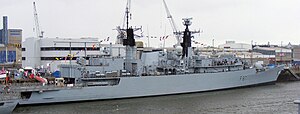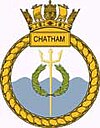
HMS Illustrious was a light aircraft carrier of the Royal Navy and the second of three Invincible-class ships constructed in the late 1970s and early 1980s. She was the fifth warship and second aircraft carrier to bear the name Illustrious, and was affectionately known to her crew as "Lusty". In 1982, the conflict in the Falklands necessitated that Illustrious be completed and rushed south to join her sister ship HMS Invincible and the veteran carrier HMS Hermes. To this end, she was brought forward by three months for completion at Swan Hunter Shipyard, then commissioned on 20 June 1982 at sea en route to Portsmouth Dockyard to take on board extra stores and crew. She arrived in the Falklands to relieve Invincible on 28 August 1982 in a steam past. Returning to the United Kingdom, she was not formally commissioned into the fleet until 20 March 1983. After her South Atlantic deployment, she was deployed on Operation Southern Watch in Iraq, then Operation Deny Flight in Bosnia during the 1990s and Operation Palliser in Sierra Leone in 2000. An extensive re-fit during 2002 prevented her from involvement in the 2003 Iraq War, but she was returned to service in time to assist British citizens trapped by the 2006 Lebanon War.

HMS Montrose was the eighth of the sixteen-ship Type 23 or Duke class of frigates, of the Royal Navy, named after the Duke of Montrose. She was laid down in November 1989 by Yarrow Shipbuilders on the Clyde, and was launched on 31 July 1992 by Edith Rifkind, wife of Malcolm Rifkind, Secretary of State for Defence. She was commissioned into service in June 1994.

The third and current HMS Argyll is a Type 23 Duke-class frigate. She is currently the oldest serving Type 23 frigate in the Royal Navy. Like all of her class she is named after a British dukedom, in this case that of Argyll. HMS Argyll was laid down in March 1987 by Yarrow Shipbuilders at Glasgow, and launched in 1989 by Lady Wendy Levene, sponsored by the Worshipful Company of Paviors. She was commissioned in May 1991. Argyll is currently based at HMNB Devonport.
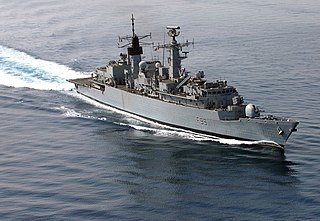
HMS Cornwall was a Batch 3 Type 22 frigate of the Royal Navy. She was the first Batch 3 to be built, and the last to decommissioned. Cornwall was based at HMNB Devonport in Devon, England, part of the Devonport Flotilla.

HMS Iron Duke is a Type 23 frigate of the Royal Navy, and the third ship to bear the name.

HMS Northumberland is a Type 23 frigate of the Royal Navy. She is named after the Duke of Northumberland. She is the eighth RN ship to bear the name since the first 70-gun ship of the line in 1679, and the ninth in the class of Type 23 frigates. She is based at Devonport and is part of the Devonport Flotilla.
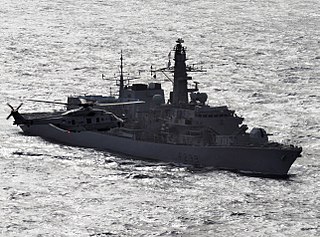
HMS Richmond is a Type 23 frigate of the Royal Navy. She was launched on 6 April 1993 by Lady Hill-Norton, wife of the late Admiral of the Fleet The Lord Hill-Norton, and was the last warship to be built by Swan Hunter Shipbuilders. She sailed from the builders on the River Tyne in November 1994. She is named for the Dukedom of Richmond.
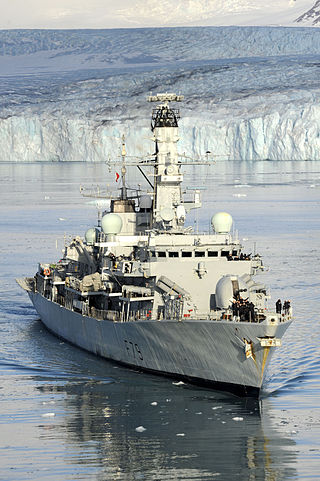
HMS Portland is a Type 23 frigate of the British Royal Navy. She is the eighth ship to bear the name and is the fifteenth and penultimate ship of the 'Duke' class of frigates, and is named for the currently extinct title of the Dukedom of Portland, and more particularly for the third Duke, who was Prime Minister.
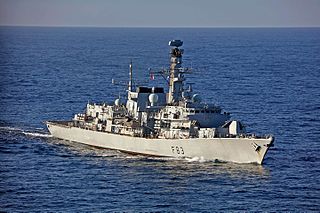
HMS St Albans is a Type 23 frigate of the Royal Navy. She is the sixth ship to bear the name and is the sixteenth and final ship in the 'Duke' class of frigates. She is based in Devonport, Plymouth.

HMS Cumberland was a Batch 3 Type 22 frigate of the British Royal Navy. She was launched in 1986 and commissioned on 10 June 1989. The frigate was on station during the First Gulf War and was part of the Devonport Flotilla based at Devonport Dockyard. Cumberland was decommissioned on 23 June 2011.

HMS Campbeltown was a Batch 3 Type 22 frigate of the British Royal Navy. Built by Cammell Laird Shipbuilders Ltd. in Birkenhead. She was part of the third batch of Type 22s, which were larger than their predecessors and incorporated advanced close-in weapons after lessons learnt from the 1982 Falklands War. She was decommissioned on 7 April 2011.

HMS Jupiter (F60) was a Batch 3 Leander-class frigate of the Royal Navy (RN). She was, like the rest of the class, named after a figure of mythology. Built by Yarrow Shipbuilders of Scotstoun, she was launched on 4 September 1967 and commissioned on 9 August 1969.

Standing Royal Navy deployments is a list of operations and commitments undertaken by the United Kingdom's Royal Navy on a worldwide basis. The following list details these commitments and deployments sorted by region and in alphabetical order. Routine deployments made by the Navy's nuclear-powered submarines and their location of operations is classified.

USS Nicholas (FFG-47), an Oliver Hazard Perry-class frigate, was the third ship of the United States Navy to be named for Major Samuel Nicholas, the first commanding officer of the United States Marines. A third-generation guided missile frigate of the Oliver Hazard Perry class, she was laid down as Bath Iron Works hull number 388 on 27 September 1982 and launched 23 April 1983. Sponsor at her commissioning there on 10 March 1984 was the same Mrs. Edward B. Tryon who sponsored DD 449 in 1942.

HDMS Absalon (F341) and her sister ship Esbern Snare are the two members of the Absalon class. The lead ship of the class is named after Danish archbishop and statesman Absalon and received full operational status in 2007.

Operation Sharp Guard was a multi-year joint naval blockade in the Adriatic Sea by NATO and the Western European Union on shipments to the former Yugoslavia. Warships and maritime patrol aircraft from 14 countries were involved in searching for and stopping blockade runners. The operation began on 15 June 1993. It was suspended on 19 June 1996, and was terminated on 2 October 1996.

RFA Wave Knight is a Wave-class fast fleet tanker of the Royal Fleet Auxiliary (RFA) of the United Kingdom tasked with providing fuel, food, fresh water, ammunition and other supplies to Royal Navy vessels around the world.

MV Dubai Moon was a cargo ship which sank on May 21, 2010 due to strong waves caused by a tropical storm. The ship was carrying vehicles in the Gulf of Aden when she was struck by Cyclone Bandu, which pushed it off the track. The ship sent a distress call which was picked by Royal Navy frigate HMS Chatham. 23 crew members were rescued by the Westland Lynx helicopter from Chatham before Dubai Moon sank.
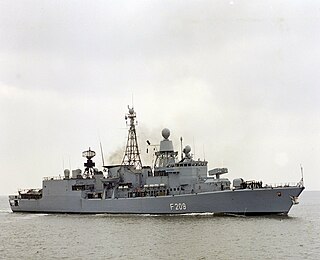
Rheinland-Pfalz was a Bremen-class frigate of the German Navy.

Emden was a Bremen-class frigate of the German Navy. She was the fourth ship of the class, and the fifth ship to serve with one of the navies of Germany to be named after the city of Emden, in Lower Saxony. Her predecessor was the frigate Emden of the Bundesmarine, one of the Köln class.
